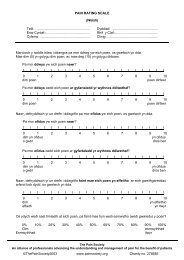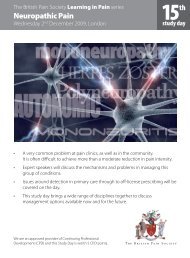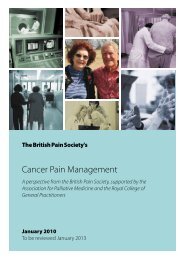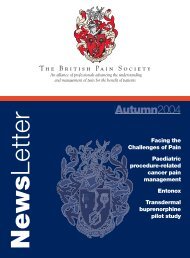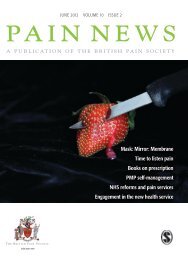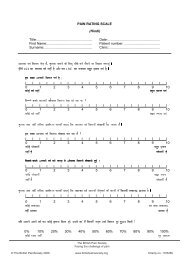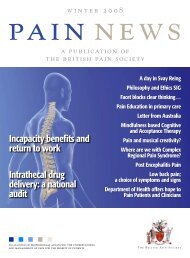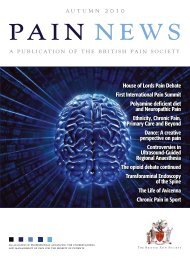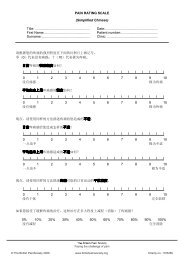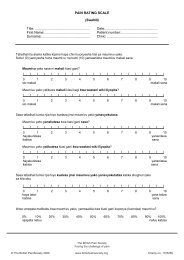Summer 2010 - The British Pain Society
Summer 2010 - The British Pain Society
Summer 2010 - The British Pain Society
You also want an ePaper? Increase the reach of your titles
YUMPU automatically turns print PDFs into web optimized ePapers that Google loves.
CHANGING PRACTICE<br />
Monitoring and<br />
intravenous access for<br />
epidural injections in<br />
chronic pain management:<br />
survey of practice<br />
Table 1. Caudal approach<br />
Caudal During procedure After Procedure<br />
NO ECG 19 / 47 (40%) 6 / 47 (13%)<br />
NO NIBP 26 / 47 (55%) 6 / 47 (13%)<br />
NO SpO2 12 / 47 (25%) 8 / 47 (17%)<br />
No intravenous access 17 / 47 (36%)<br />
Table 2. Lumbar approach<br />
Lumbar During procedure After procedure<br />
NO ECG 18 / 45 (40%) 9 /45 (20%)<br />
NO NIBP 23 / 45 (51%) 7 / 45 (15%)<br />
NO SpO2 12 / 45 (27%) 10 / 45 (22%)<br />
No intravenous access 12 / 45 (27%)<br />
Dr Iordan Mihaylov<br />
Dr Shyam Balasubramanian<br />
University Hospitals Coventry and<br />
Warwickshire<br />
Epidural injections are performed<br />
for pain secondary to nerve root<br />
irritation. <strong>The</strong> three common<br />
approaches for the epidural<br />
injections are lumbar, caudal and<br />
transforaminal routes. Although<br />
pain clinicians perform these<br />
procedures frequently, there<br />
is paucity of robust guidelines.<br />
We require evidence based<br />
information on the medications<br />
used, need for intravenous access<br />
and the minimum monitoring<br />
standards during and after the<br />
procedure. <strong>The</strong> Royal College<br />
of Anaesthetists and <strong>British</strong><br />
<strong>Pain</strong> <strong>Society</strong> have published<br />
recommendations in 2002<br />
regarding the minimum standards<br />
of monitoring required for the<br />
performance of epidurals via<br />
the lumbar and caudal routes if<br />
local anaesthetics are injected.<br />
This includes blood pressure and<br />
pulse oximetry during and blood<br />
pressure and heart rate after the<br />
procedure (1).<br />
We conducted a prospective<br />
survey of practice of members<br />
attending the Interventional<br />
<strong>Pain</strong> Medicine Special Interest<br />
Group meeting in Manchester,<br />
9th October 2009. Fifty two out<br />
of fifty eight clinicians completed<br />
the survey questionnaire, making<br />
it a 90% response rate; 46 were<br />
consultants, one was an associate<br />
specialist and five were trainees.<br />
Results<br />
<strong>The</strong>re was a wide variation<br />
with the amount and volume<br />
of medication injected. In the<br />
caudal and lumbar approach,<br />
the local anaesthetic injected<br />
ranged between three and twenty<br />
mls of 0.25% bupivacaine (or<br />
levobupivacaine). <strong>The</strong> volume was<br />
between one and four mls in the<br />
transforaminal approach. Two of<br />
the participants preferred lidocaine<br />
0.5% over bupivacaine for the<br />
lumbar and caudal approach.<br />
<strong>The</strong> status of intravenous access<br />
for these procedures and the<br />
monitoring used are presented in<br />
the tables 1-3.<br />
<strong>The</strong> results highlight that about<br />
one third of the epidural injections<br />
are done without intravenous<br />
access. It is debatable whether<br />
intravenous access is necessary if a<br />
small amount of local anaesthetic<br />
is injected into the epidural<br />
space (although the potential risk<br />
of intrathecal spread is always<br />
present). We noticed that many<br />
of the clinicians inject significant<br />
Table 3. Transforaminal approach<br />
Transforaminal During procedure After procedure<br />
NO ECG 14 / 37 (38%) 6 / 37 (16%)<br />
NO NIBP 22 / 37 (59%) 5 / 37 (13%)<br />
NO SpO2 9 / 37 (24%) 6 / 37 (16%)<br />
No intravenous access 11 / 37 (30%)<br />
amount of bupivacaine 0.25% (5 –<br />
20 ml) without intravenous access.<br />
<strong>The</strong> results also suggest that the<br />
level of monitoring was often<br />
better after the procedure rather<br />
than during the procedure. Whilst<br />
the post-procedure monitoring<br />
is more important to rule out<br />
any haemodynamic changes,<br />
monitoring during the procedure<br />
may equally be necessary<br />
to identify episodes such as<br />
vasovagal syncope. <strong>The</strong> purpose of<br />
the audit is to survey the practice<br />
rather than analyse the outcome<br />
of these procedures.<br />
Conclusion<br />
<strong>The</strong> practice guidelines from<br />
International Spine Intervention<br />
<strong>Society</strong> (2) recommends<br />
physiologic monitoring and<br />
intravenous access for all<br />
procedures in which needles are<br />
placed near the dural sac.<br />
Although epidural techniques for<br />
pain management have been in<br />
existence for several decades,<br />
practitioners learn the techniques<br />
and the practice in different<br />
ways. <strong>The</strong> performance is based<br />
on personal experience rather<br />
than on robust evidence. One<br />
of the widely raised concerns<br />
and the discussion following the<br />
publication of the recent NICE<br />
low back pain guidelines was the<br />
heterogeneity of the interventional<br />
pain practice. Many of us agree<br />
that interventional treatment<br />
procedures form an important<br />
facet in pain management. Whilst<br />
there are several hurdles in<br />
bringing uniformity to the practice<br />
due to the multiple variables in<br />
the nature of the patients we deal<br />
with and the available resources,<br />
still efforts must be taken to<br />
standardise our practice as much<br />
as we can. To survive in a world<br />
of evidence based medicine,<br />
focus should be on establishing a<br />
guideline development group to<br />
bring consistency to our practice.<br />
Reference<br />
1. http://www.britishpainsociety.<br />
org/epi_inj.pdf<br />
2. Spinal Diagnostic & Treatment<br />
Procedures 2004, International<br />
Spine Intervention <strong>Society</strong><br />
(ISBN 0-9744402-0-5)<br />
5 8<br />
PAI N N E W S S U M M E R <strong>2010</strong>




